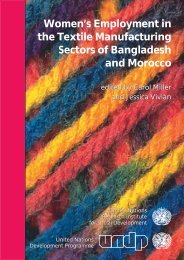The Politics of Gender and Reconstruction in Afghanistan
The Politics of Gender and Reconstruction in Afghanistan
The Politics of Gender and Reconstruction in Afghanistan
Create successful ePaper yourself
Turn your PDF publications into a flip-book with our unique Google optimized e-Paper software.
EVOLVING INSTITUTIONAL FRAMEWORKS AND WOMEN’S RIGHTS: POTENTIALS AND LIMITATIONS<br />
This is the backdrop aga<strong>in</strong>st which gender-ma<strong>in</strong>stream<strong>in</strong>g efforts <strong>in</strong> the process <strong>of</strong> reconstruction <strong>and</strong> <strong>in</strong>stitutional<br />
reform <strong>in</strong> <strong>Afghanistan</strong> must be evaluated. An important caveat must be the recognition that focus<strong>in</strong>g<br />
on government programmes <strong>and</strong> policies suffers from self-evident limitations <strong>in</strong> a context where the transition<br />
from war to peace is still <strong>in</strong>complete <strong>and</strong> where the illicit economy, <strong>and</strong> those who pr<strong>of</strong>it from it, cont<strong>in</strong>ue to<br />
comm<strong>and</strong> substantial resources <strong>and</strong> to fuel cont<strong>in</strong>u<strong>in</strong>g <strong>in</strong>stability. Nonetheless, despite the currently limited<br />
reach <strong>of</strong> the <strong>in</strong>stitutional framework created by the Bonn Agreement, there have been some successful attempts<br />
to put the issue <strong>of</strong> women’s rights on the policy agenda. <strong>The</strong>se attempts are discussed below.<br />
IV.A.<br />
l<strong>and</strong>marks <strong>in</strong> state-build<strong>in</strong>g:<br />
the Bonn agreement <strong>and</strong><br />
the national development<br />
framework<br />
Writ<strong>in</strong>g a year after the fall <strong>of</strong> the Taliban, Thier po<strong>in</strong>ted<br />
to several <strong>in</strong>tertw<strong>in</strong>ed str<strong>and</strong>s <strong>of</strong> “<strong>in</strong>tervention <strong>and</strong><br />
entropy” <strong>in</strong> the political transformation <strong>of</strong> <strong>Afghanistan</strong>:<br />
the (re)creation <strong>of</strong> a central state, the cont<strong>in</strong>u<strong>in</strong>g “war<br />
on terrorism”, <strong>and</strong> a relapse <strong>in</strong>to division <strong>and</strong> conflict <strong>in</strong><br />
the countryside (2004b:39). Three years on, these parameters<br />
broadly appear to hold. Nonetheless, the Bonn<br />
Agreement laid out a framework <strong>and</strong> timetable for state-build<strong>in</strong>g <strong>and</strong> peace consolidation <strong>in</strong> <strong>Afghanistan</strong>. <strong>The</strong><br />
agreement endorsed the establishment <strong>of</strong> “a broad-based, gender-sensitive, multi-ethnic <strong>and</strong> fully representative<br />
government”. 25 This was not a conventional peace agreement, however, s<strong>in</strong>ce not all the warr<strong>in</strong>g parties were<br />
represented <strong>and</strong> it lacked specific <strong>and</strong> actionable clauses on disarmament, demobilization <strong>and</strong> re<strong>in</strong>tegration<br />
(DDR) (Rub<strong>in</strong> 2003). Instead, it was an externally mediated power-shar<strong>in</strong>g arrangement between the Northern<br />
Alliance <strong>and</strong> the <strong>in</strong>ternational community, lead<strong>in</strong>g to a peace that was fragile because <strong>of</strong> both opposition from<br />
those who rema<strong>in</strong>ed outside the nascent Bonn framework <strong>and</strong> the uneasy stalemate between the armed factions<br />
with<strong>in</strong> it.<br />
<strong>The</strong> Agreement laid the groundwork for several <strong>in</strong>stitutional developments with a direct bear<strong>in</strong>g on the representation<br />
<strong>of</strong> women’s <strong>in</strong>terests:<br />
• the creation <strong>of</strong> an <strong>in</strong>terim authority with a life-span <strong>of</strong> six months, to be superseded by a transitional<br />
authority, chosen by an Emergency Loya Jirga (ELJ) to lead the country until such time as a government<br />
based on free <strong>and</strong> fair elections can come <strong>in</strong>to be<strong>in</strong>g<br />
• the draft<strong>in</strong>g <strong>of</strong> a new constitution, to be approved by a Constitutional Loya Jirga (CLJ) that would be<br />
convened two years after the Bonn Agreement<br />
• the establishment <strong>of</strong> a M<strong>in</strong>istry <strong>of</strong> Women’s Affairs (MOWA) charged with ma<strong>in</strong>stream<strong>in</strong>g gender <strong>in</strong>to the<br />
policies <strong>and</strong> programmes <strong>of</strong> the l<strong>in</strong>e m<strong>in</strong>istries to ensure that gender equity concerns are addressed.<br />
By the time <strong>of</strong> the fall <strong>of</strong> the Taliban, <strong>Afghanistan</strong>’s formal economy was entirely dependent on external<br />
resources. <strong>The</strong> Bonn Agreement created a concept <strong>of</strong> Afghan sovereignty that, <strong>in</strong> the absence <strong>of</strong> the most<br />
basic functions <strong>of</strong> statehood (fiscal management, <strong>in</strong>ternal security <strong>and</strong> social service provision), required a<br />
great deal <strong>of</strong> effort if it was to become a reality. One <strong>of</strong> the first priorities <strong>of</strong> the <strong>in</strong>terim adm<strong>in</strong>istration was to<br />
25 <strong>The</strong> Bonn Agreement Preamble.<br />
PAGE 15
















